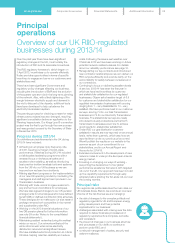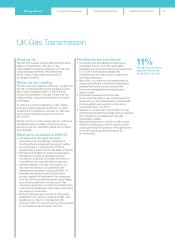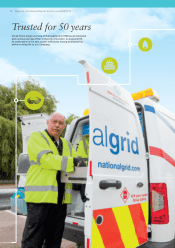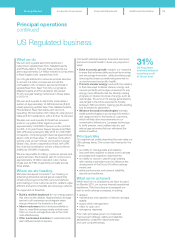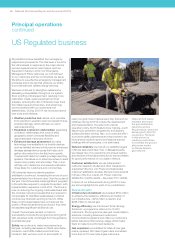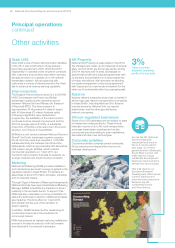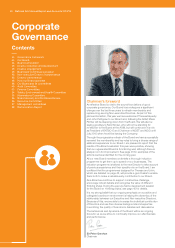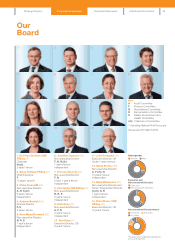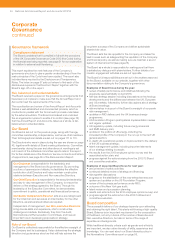National Grid 2014 Annual Report Download - page 37
Download and view the complete annual report
Please find page 37 of the 2014 National Grid annual report below. You can navigate through the pages in the report by either clicking on the pages listed below, or by using the keyword search tool below to find specific information within the annual report.
Strategic Report Corporate Governance Financial Statements Additional Information
Principal operations
continued
US Regulated business
What we do
We own and operate electricity distribution
networksin upstate New York, Massachusetts,
andRhode Island. Through these networks we
serve approximately 3.4 million electricity consumers
in New England and upstate New York.
Our US gas distribution networks provide services
toaround 3.6 million consumers across the
northeastern US, located in service territories in
upstate New York, New York City, Long Island,
Massachusetts and Rhode Island. We added
31,145new gas heating customers in these areas
in2013/14.
We own and operate an electricity transmission
system of approximately 14,328 kilometres (8,903
miles) spanning upstate New York, Massachusetts,
Rhode Island, New Hampshire and Vermont,
operating 169 kilometres (105 miles) of underground
cable and 521 substations, with a further 12 planned.
We also own and operate 50 fossil fuel-powered
units on Long Island that together provide
approximately 3,800 MW of power under contract
toLIPA. A 15 year Power Supply Agreement (PSA)
with LIPA was renewed in May 2013 for 3,634 MW
ofcapacity, comprising eight dual fuel (gas/oil-fired)
steam units at three sites, 11 dual fuel combustion
turbine units, and 27 oil-fired combustion turbine/
diesel units. Under a separate contract with LIPA,
four dual fuel combustion turbine units provide an
additional 160 MW of capacity.
We are responsible for billing, customer service and
supply services. We forecast, plan for and procure
approximately 15 billion standard cubic metres
ofgas and 32 TWh of electricity annually across
three states.
Where we are heading
We have introduced Connect21, our thinking on
advancing America’s natural gas and electricity
infrastructure beyond its 20th century limitations,
and creating a more customer-centric, resilient, agile,
efficient and environmentally sound energy network.
Our approach is threefold:
• Build a resilient backbone for our energy system
that can provide reliable, flexible electric and gas
service to all customers and integrate clean
energy wherever it is located on the grid.
• Inform customers about choices available to
them to meet their energy needs and educate
them on how to manage their use in the most
cost-effective way.
• Offer customised solutions to customers who
want different levels of service.
Connect21 will help develop America’s economic
and environmental health in three very important
ways:
• Drive economic growth: invest in our networks
in ways that enhance state and local economies
and encourage innovation, while simultaneously
reducing the stress currently being exerted on
ourenvironment and public health.
• Promote cleaner energy: work with the industry
to find new ways to deliver cleaner energy, and
more importantly encourage consumers to use
energy more efficiently. We are already making
progress on cleaner sources of energy, such as
natural gas. The amount of energy generated by
natural gas in the US is expected to double
between 1990 and 2040, making gas the leading
fuel for electricity generation.
• Advance innovative technologies: harness
existing technologies to put energy information
and usage control in the hands of customers,
which will help drive improvements in our
consumption behaviours. Leverage technology
tobuild smarter, more resilient electric and
naturalgas networks that can withstand the
extreme weather.
Principal risks
Our regional risk profile describes the main risks our
US business faces. The current risk themes for the
US are:
• our ability to manage data and systems
improvements required to deliver core business
processes and regulatory requirements;
• our ability to recover costs through existing
rate-making mechanisms and to influence the
development of the future US utility business
model; and
• safety performance and network reliability,
security and resilience.
What we’ve achieved
Within each of our jurisdictions we have focused
onElevate 2015, our journey towards operational
excellence. This focus has encompassed our
end-to-end business processes, including:
• delivery;
• maintenance and operation of electric and gas
assets;
• supply chain management;
• meter to cash; and
• emergency response.
Four main principles govern our business
improvement strategy: safety and reliability;
stewardship; customer responsiveness;
andcostcompetitiveness.
31%
US Regulated
business adjusted
operating profit
ofGroup total
35






